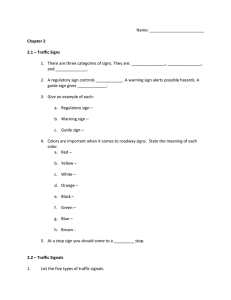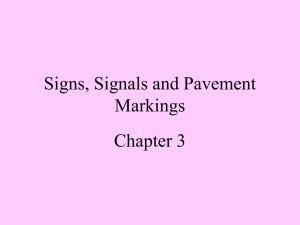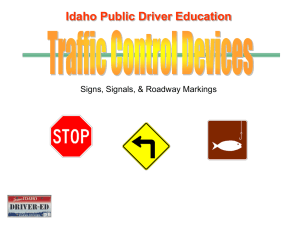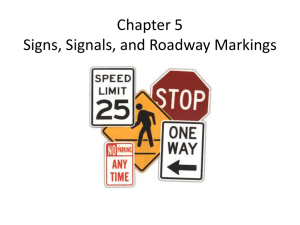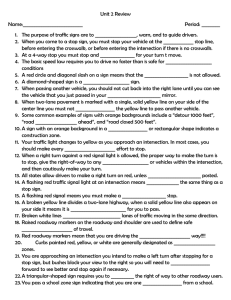Document 13037923
advertisement
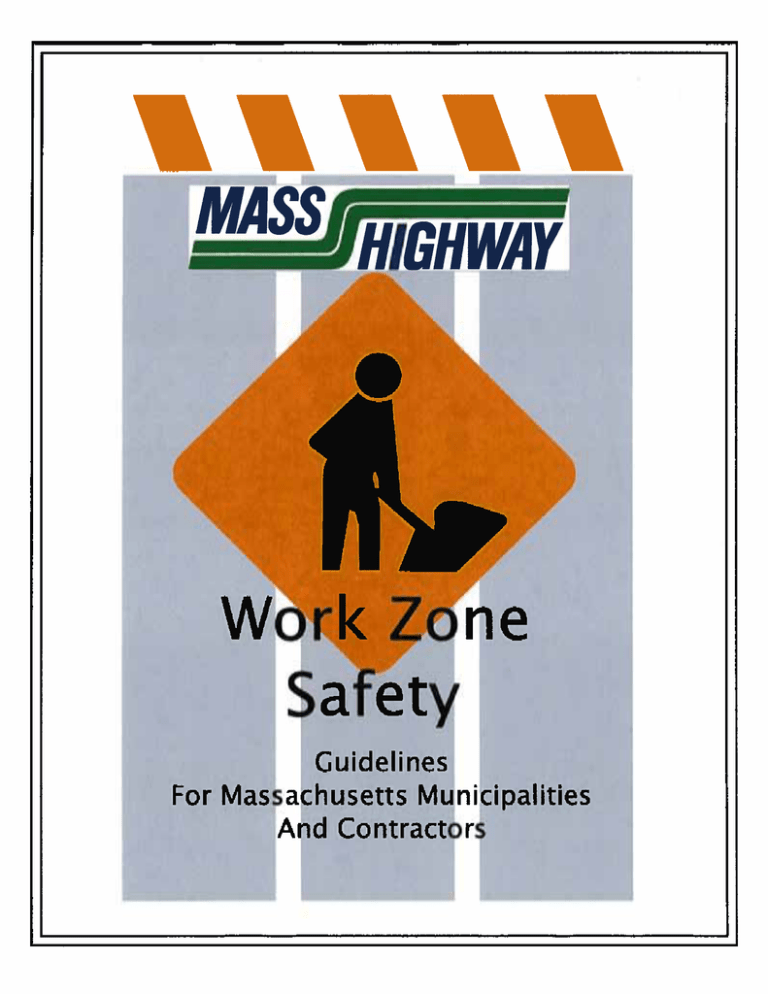
INTRODUCTION This guide has been prepared for the supervisors and foremen who are responsible for planning and installing temporary traffic controls in maintenance, utility, or shortterm construction work areas (work less than 8 hours). It is to help with the many decisions that must be made for each work site. Special planning for traffic control is necessary on a case by case basis because conditions can vary widely among work locations. Since this guide cannot cover every situation, representative illustrations covering typical maintenance/ utility/ short-term construction operations and conditions are presented. All typical traffic control device setups that are illustrated should be considered as guides. The traffic control devices that are shown, the arrangement or position of the devices, and the distances prescribed in the tables are based on the Federal Highway Administration’s (FHWA) Manual on Uniform Traffic Control Devices (MUTCD), but these only show minimum standards. Recently updated Federal Regulations (the FHWA’s Rule on Work Zone Safety and Mobility) emphasize the importance of providing safe work areas for motorists, workers, and others affected by the maintenance/ utility/ construction activities. You may expand or improve traffic controls whenever the need is indicated. You must always observe traffic movement through the work site, and inspect all traffic control devices periodically at each location. If additional guidance or information is needed, you should refer to Part 6 of the MUTCD for additional suggestions and work zone setups; to Chapter 17 (Work Zone Management) of MassHighway’s Project Development & Design Guide; to any MassHighway office; or to the “Traffic Management Plans” section of the MassHighway web site ( http://www.mhd.state.ma.us/ ). RESPONSIBILITIES FOR TRAFFIC CONTROL Maintenance, utility, or short-term construction work that takes place either on or near the roadway creates a potentially hazardous situation, which normally will require the use of temporary traffic controls. These controls are important to protect both work crews and the motoring public. It is the responsibility of each highway maintenance foreman to establish and maintain safe and effective controls. Usually the work supervisor, working with the crew, plans the traffic control procedures for proposed work sites. Section foremen are responsible for requesting, storing, and maintaining all traffic control devices that are needed by their crews. The foreman of each crew has the responsibility of placing the devices according to these guidelines. He/ She must inspect each installation and observe traffic flow through the area. The section foreman is generally authorized to make adjustments to the original installations that, in his/ her judgment, are needed to improve the control of traffic and establish greater safety. All necessary traffic control devices must be installed before work begins and be properly maintained during the work period. They must also be removed p. 1 p. 2 as soon as work is completed in that area. In particularly hazardous situations such as night time road or lane closures, detours, or other unusual conditions, the District Traffic Maintenance Engineer (DTME) should be advised. If the DTME is absent, the section foreman will follow the instructions of the District Maintenance Engineer. TRAFFIC CONTROL DEVICES Traffic control devices warn drivers of unexpected or unusual roadway conditions and inform them how to move safely through or around the work area. All signs, cones, barricades, plastic drums, and other miscellaneous traffic control devices should work together to guide traffic safely and efficiently. Common temporary traffic control devices are outlined and described below. Signs Temporary traffic control zone (TTCZ) signs are the primary means of providing information and giving directions to motorists. Warning signs provide initial directions to be alert to changes in the roadway and in driving patterns. Nearly all warning signs for construction and work areas have black legends and borders on an orange background. Regulatory signs and Guide signs, when used, tell the driver how he/ she must change speed or direction in order to pass through the work area safely. All signs must be fully reflectorized or illuminated when used at night. Special Lighting Units (SLU) [Flashing Arrow Boards] Arrow boards/ SLU are a special type of sign that is a highly visible work zone warning device. They are particularly effective on highways where both speed and volume are high. SLU’s in the non-directional CAUTION mode may be used to indicate that a travel lane or shoulder is closed, but SLU’s in the arrow mode may only be used when a travel lane is being dropped and one lane of traffic must merge with another. All arrow boards should be located at the beginning of each travel lane taper without extending outside of the taper. Channelizing Devices When used properly, traffic cones, reflectorized plastic drums, and barricades guide traffic away from the work area and into an appropriate travel path. It takes drivers a certain distance along the roadway to safely move away from the upcoming work area, and those transition distances are based on the following taper length formulas: L = WS2/60 for speeds of 40 mph or less, or L = WS for speeds of 45 mph or more, where L = minimum length of taper in feet, S = posted speed limit or typical travel speed in miles per hour prior to the work, and W = width of lane closure in feet. Spacing of channelizing devices (in feet) is approximately equal to the existing speed of traffic (in mph). Warning Lights Rotating beacons, SLU’s, and other flashing lights mounted on work vehicles, as well as flashing lights mounted on signs or channelizing devices, help to call the motorist’s attention to the work area. They may also be used to alert the motorist to a potentially hazardous section within the work area. BASIC REQUIREMENTS In every work situation, you must: • give drivers sufficient advance warning of the work area; • advise motorists of the proper actions to take and travel paths to follow; and • provide protection for motorists, workers, and the work area. These three general requirements can be met as outlined below. Provide Advance Warning Warning devices on the approaches to a work area alert the driver to a change in road and operating conditions. This is usually accomplished by using a sign or series of signs installed in the same order as the driver generally would expect to see them on long-term construction projects. The initial advance warning sign is usually a general warning such as “ROAD WORK 1500 FT”. Other operational warning signs then provide the driver with more specific information about the situation. A minimum of three advance warning signs (the initial advance warning sign and two operational warning signs) is recommended when work is located on the traveled way. Warning lights and flags can be used to attract attention to the signs. A highly visible work area helps to reinforce the advance warnings. Advise and Direct Motorists The other two operational warning signs provide information to the driver such as the type of work, special conditions to watch for, or what actions to take. These include signs such as SHOULDER WORK, RIGHT LANE ENDS, DETOUR 500 FT, ROAD CLOSED to THRU TRAFFIC, POLICE OFFICER AHEAD, etc. All of these signs must be located far enough in advance of the work area that drivers have sufficient time to react to them appropriately. For projects in Urban Areas, see page 8 for minimum sign spacings. Protect Motorists, Workers, and the Work Area The primary protection of any work area is its own visibility. Traffic cones, temporary concrete barriers, reflectorized plastic drums, portable breakaway barricades, etc. are used to make the work area visible and to separate the workers from traffic. Other devices, such as flashing lights, flags, p. 3 p. 4 delineators, and portable changeable message signs (PCMS) can be used for additional emphasis and visibility. Workers must protect themselves by being alert to their work situation, wearing safety vests and hard hats, and by facing traffic whenever possible. Work vehicles can also add protection when they are equipped with rotating beacons, flashing lights, flashing arrow panels, etc. and are parked between workers and oncoming traffic. However, workers should not position themselves between two closely parked vehicles. PLANNING GUIDELINES Decisions regarding selection of work area traffic control devices require a knowledge and understanding of the specifics of each work area. It should be noted that the MUTCD does not require police/ flaggers for stationary setups. However, there may be vast differences between situations, so there are three main variables that need to be considered prior to determining the need for, or the selection of, traffic control devices: 1) location of work, 2) type of roadway, and 3) speed of traffic. If flaggers are used, the “flagger ahead” sign should be used in advance of any point where the flagger is stationed to control road users. Compiling information about these variables will help you plan safe work area control. Each of these is explained below. Location of Work The choice of traffic controls needed for a maintenance, utility, or short-term construction operation (less than an 8 hour duration) will depend upon where the work is located. As a general rule, the closer the work area is to the roadway, the more the control devices that are needed. Work can take place: • Away from the shoulder/ edge of pavement. No special devices are needed if work is confined to an area 15 or more feet from the edge of the shoulder. Use a general warning sign such as ROAD WORK AHEAD if workers and equipment must occasionally move closer to the highway. • On or near the shoulder/ edge of pavement. This area should be signed as if work were on the road itself, since it is part of the motorists’ “recovery area”. Advance warning and operational signs are needed, as well as cones, reflectorized plastic drums, or temporary barricades to direct traffic and keep the work area visible to drivers. • On the median of a divided highway. Work in this location may require traffic control for both directions of traffic, using advance warning and channelization devices if the median is narrow. • On the roadway. This situation demands optimum protection for workers and maximum warning for motorists. Advance warning must provide a general message that work is taking place, as well as information about specific hazards and specific actions the driver must take. Type of Roadway The characteristics of the roadway also have an important influence on the work area traffic control needed. The roadway itself may present special hazards. You should plan for maximum protection, using the worst hazard present as your guide to signing the work area. Some general considerations are described below for one- and two-way roads, number of lanes, kinds of road edges, and sight obstructions. • One-way roads. A one-way road requires signing on both sides if there are two or more lanes in one direction of the road, so motorists in all lanes are alerted and informed. • Two-way roads. o Undivided: Two-way, undivided roads will usually require controls for both directions of traffic. When the work area is well off the roadway, controls for the opposite lane may be eliminated. o Divided: Work on divided multi-lane roadways can often be handled like a one-way road: sign both sides of the direction affected. But if the work is in the median, both directions of traffic must be controlled, and both approaches should be double signed (i. e. have all 3 advance warning/ operational signs on both sides of each direction). • Sight Obstructions. To ensure safety, work areas must be visible. Test the placement of the temporary traffic control devices by driving through the area, and determine if the devices can be easily seen and provide sufficient time for drivers to react in a safe manner. Extra precaution should be enacted in areas where horizontal or vertical curves may obstruct a driver’s clear view of road activities ahead. Speed of Traffic Speed is an important consideration in the use of work area traffic control devices. As a general rule, the greater the speed of traffic approaching a work area, the greater the size, number, and spacing of controls devices. • Size. The standard size for most warning signs is 36 x 36 inches (48 x 48 inches for Interstate highways). Signs larger than the standard 36 x 36 inches may be desirable on high-speed roads. • Position. Locate signs far enough in advance of the work area so the motorist has time to react to them (see charts located on diagrams for spacing). CHECK LIST FOR WORK AREA TRAFFIC CONTROL 1. PLAN YOUR WORK • Inspect location of work area and its surroundings. • Analyze: o location of work in relation to the traveled way, intersecting road- p. 5 p. 6 ways, driveways, and sight distances, o type of roadway and traffic involved, and o volume and speed of traffic • Meet and discuss the work and needed traffic control with the crew. • Study representative illustrations in this guide to develop a temporary traffic control (TTC) plan. Considerations • Base your traffic control plan on the premise that all drivers are unfamiliar with the area. • The closer the work area location is to traffic, the more controls you’ will need. • Plan for maximum protection. 2. INSTALL TRAFFIC CONTROL DEVICES AT WORK SITE • Select the temporary control devices needed, then collect and transport them to the work site. • Determine their proper placement. • Install the devices. o Where one direction of traffic is being affected, the first sign installed should be the sign farthest from the work site, and on the same side as the work. o Where two directions of traffic are affected, install signs for opposing traffic first, with the first sign still the one farthest from the work area. When signs for opposing traffic have been installed, install signs on the same side as the work area, again beginning with the sign farthest from the work area. Considerations • Inspect signs and other devices before using; if they are not in good condition, REPLACE THEM ! • Install signs before allowing personnel or equipment onto the roadway. • Make sure signs are accurate, clean, and meet specifications. • Cover any existing permanent signs that will conflict with the messages of the new work area control signs. 3. INSPECT WORK AREA SIGNING AND CONTROL DEVICES • You need to test the placement of the temporary traffic control devices by driving through the work area. All approaches to the work zone should be checked. • Make sure drivers will have sufficient time to read signs and react in a safe manner. • Check visibility of entire work area. If approaching drivers can’t see the work area well, or if they can’t see ahead to traffic that may already be backed up on the approach because of the work, additional traffic control devices should be employed. • Check to see that equipment is parked to protect workers from traffic (where possible). • Make sure all workers wear safety vests and hard hats. • Record in diary the number of signs and their location. Considerations • Work area signs should never be blocked from view or obscured by vegetation, existing signs, or other obstructions. • Flags, flashing lights, and edge line traffic cones can be used to improve visibility. 4. REMOVE TRAFFIC CONTROLS • Remove signs and other devices when work is complete. • Remove workers and equipment from work site BEFORE removing signs and other devices. • Remove signs in the reverse order in which they were installed (i. e. sign closest to the work area to be removed first). • When operation is complete, uncover any existing permanent signs covered in Step 2, and • Record in diary when the signs were removed. USE OF THIS GUIDE Illustrations showing minimum standards for short-term construction, utility, and maintenance operations (less than an 8 hour duration) are arranged in this guide by type of operation. First, compare all illustrated examples and examine their differences. Next, gather information about the work areas using the general guidelines as outlined, and proceed as follows: 1. Turn to the Index. Consider the type of operations and the type of road to select the figure(s) which best reflect the condition of your work area. 2. Select the figure that most closely matches the conditions where you plan to work. Remember that all diagrams represent minimum standards. 3. Read the title of the illustration to make sure that it is appropriate for your location. Study the layout of traffic control devices and read all notes. 4. Consult the appropriate tables, as directed on each illustration, to determine taper length and proper spacing of signs. Notice that distances change when speeds change. Also note that these are guidelines, and must be adapted to your specific work area. 5. Use the “CHECKLIST FOR WORK AREA TRAFFIC CONTROL” for assistance in completing all necessary steps for effective and safe work area traffic control. p. 7 p. 12 Flagger Tips continued (The Escape Route) A flagger should always be aware of their surroundings and have a good escape route. A flagger should never be positioned directly beside or against construction equipment. When a flagger is required to direct traffic in an area where the escape route is partially blocked by a traversable obstruction such as a guardrail, the flagger shall be physically capable of traversing that obstruction. Prior to commencing a project, the supervisor in charge should review the project, including guardrail areas, for safe flagging stations. The supervisor in charge should clearly communicate with the flagger (s), indicating any locations where they cannot safely perform their duties. INDEX Stationary Operations S-1 .........Two-lane undivided roadway: half of roadway closed - work near a curve. S-2 .........Two-lane undivided roadway: half of roadway closed. S-3 .........Two-lane undivided roadway: shoulder closed S-4 .........Two-lane undivided roadway: shoulder and half of roadway closed maintain two way traffic. S-5 .........Four-lane undivided roadway: right lane closed. S-6 .........Four-lane undivided roadway: left lane closed. S-7 .........Four-lane undivided roadway: half of roadway closed. S-8 .........Multi-lane divided roadway: center lane or right/center lanes closed S-9 .........Multi-lane divided roadway: center lane or left/center lanes closed S-10 .......Multi-lane divided roadway: Off-ramp-right side of ramp closed. S-11 .......Multi-lane divided roadway: Off-ramp-Ieft side of ramp closed. S-12 .......Multi-lane divided roadway: Road work beyond off ramp. S-13 .......Multi-lane divided roadway: Road work beyond on ramp. Mobile Operations M-1.........Any roadway: Beyond Right Shoulder. M-2.........Any roadway: Shoulder. M-3.........Multi-lane divided roadway: Median Work. M-4.........Undivided Two Lane Roadway: Half of Road Closed M-5.........Multi-lane divided roadway: Right Travel Lane. M-6.........Multi-lane divided roadway: Left Travel Lane. M-7.........Multi-lane divided roadway: Center Lane. M-8.........Post Storm Cleanup Operations Emergency Response Incidents E-1 .........Any Roadway: shoulder/breakdown lane, no encroachment of roadway. E-2 .........Two-Lane Roadway - No Shoulder: part or all of travel lane, encroachment of roadway/travel lane. E-3 .........Two-Lane Roadway: part or all of travel lane, encroachment of roadway/travel lane. E-4 .........Two-Lane Roadway: center of road. E-5 .........Multi-Lane Undivided or Divided Roadway: right travel lane. E-6 .........Multi-Lane Divided Roadway: left travel lane. E-7 .........Multi-Lane Undivided Roadway: left travel lane. E-8 .........Divided Roadway: middle lanes. E-9 .........Divided Roadway: center lane. Electricians - Traffic Signal Repair at Intersections TS-1 .......Multi-Lane Undivided Roadway - Left Lane or Left turning lane. TS-2 .......One-Lane Bidirectional Undivided - One leg of intersection. TS-3 .......Multi-Lane Undivided Roadway - Intersection Center.
